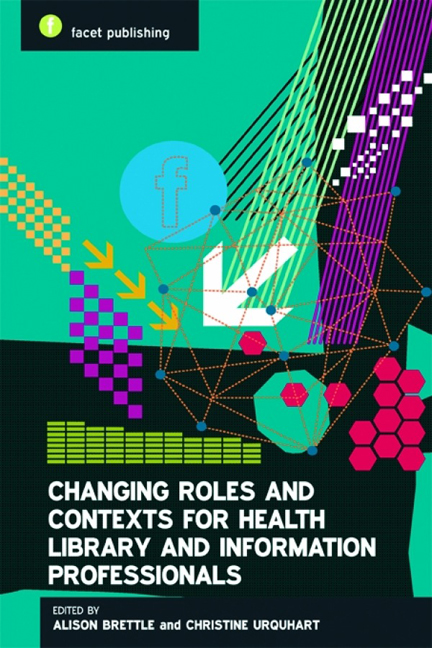Book contents
- Frontmatter
- Contents
- About the editors
- List of contributors
- Overview
- Part 1 Context
- 1 The changing context of health for library and information professionals
- 2 Changes in information generation and use
- 3 Changing technology to meet clinicians’ information needs
- 4 The influences of governance, consumers and evidence-based practice
- Part 2 Roles
- Conclusion
- Index
3 - Changing technology to meet clinicians’ information needs
from Part 1 - Context
Published online by Cambridge University Press: 08 June 2018
- Frontmatter
- Contents
- About the editors
- List of contributors
- Overview
- Part 1 Context
- 1 The changing context of health for library and information professionals
- 2 Changes in information generation and use
- 3 Changing technology to meet clinicians’ information needs
- 4 The influences of governance, consumers and evidence-based practice
- Part 2 Roles
- Conclusion
- Index
Summary
Introduction
Information technology has dramatically changed all our lives over recent years. For those working in the health sector, this has been no exception. This chapter begins with an overview by Nicholas Hardiker of the information needs of clinicians and the technology and information systems that may be used to answer them. This is followed by two examples of that technology in action: the first is a description of the Map of Medicine clinical information system by Joanna Dundon, and the second, by Jessie McGowan, describes a project which uses personal digital assistants (PDAs) to bring clinical information directly to the clinicians who need it.
CLINICIANS’ INFORMATION NEEDS
Nicholas R. Hardiker
Clinicians face important decisions every day. They must be able to answer, sometimes immediately, a range of questions: ‘What is the accepted assessment process for a particular group of patients?’; ‘What is the most likely diagnosis given a set of signs and symptoms?’; ‘What is the most effective treatment for a particular condition?’; ‘What are the potential adverse effects of a particular medicine?’; and so on. The process of asking and answering clinical questions has been summarized as: (1) recognizing uncertainty; (2) formulating a question; (3) pursuing an answer; (4) finding an answer; and (5) applying the answer in practice. Most questions go unanswered – clinicians do not always pursue answers to their questions, perhaps because of doubt that an answer actually exists. And where clinicians do pursue answers, the answers cannot always be found, perhaps due to lack of time, an inability to access appropriate resources or an inability to navigate a particular resource (Ely et al., 2005). Potential solutions rest with clinicians themselves – selecting the most appropriate resource, formulating questions to match particular resources and using more effective search terms. Other solutions concern clinical inform ation resources and systems that seek to make relevant information more accessible at the point of care – anticipating questions that may arise in practice and providing clearer, more explicit and actionable answers (Ely et al., 2007). An understanding of clinical infor mation needs is an important precondition to the development of clinical information resources and systems (Smith, 1996). The focus of this chapter is on the resources and systems themselves.
- Type
- Chapter
- Information
- Publisher: FacetPrint publication year: 2011

